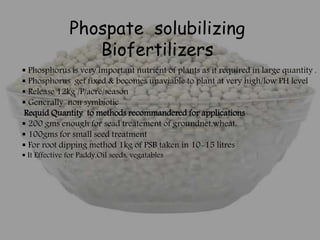Biofertilizers slide share by ssk
- 1. Veltech Dr.RR & Dr.SR University Subject :Biology For Engineers (1150GE101) Topic : Biofertilizers
- 3. What is Biofertilizer ? A biological active products of bacteria,algai,fungi which gives plant nutrients by fixation /solubilization.
- 5. Types of biofertilizers(Organic) N2 Fixing Phospate solubilizing Biofertilizers for Micro nutrients(new) PGPR Phosphate mobilizing Free living Azotobacter, Anabaena, Blue green algae. Bacteria Bacillus subtilles Fungi Pencillium sp Symboitic Rhizobium Anabaena azollae Associative Symboitic Azospirillum Silicate and Zinc solubilizers Bacillus Pseudomonas Pseudomonas fluorescence Mycorrihiza Glomus sp Amanita sp Boletus sp
- 6. Nitrogen fixing Biofertilizers Rhizobium : Most popular biofertilizer Contain symbiotic bacterium Mixed with charcoal powder Present in root nodes of legumes plants Fixes 20-40 kg of N/acre/sesion Brings 15-30% improvement in year Effectivness Dependance: 1. Soil type 2. Climate conditions etc.. Ex:(Red,Black,Green)Bengal gram(pulses)Soa bean(Oil seeds,) etc…..
- 7. Azotobacter : A free living Nitrogen fixing aerobic bacterium(Activity) Fixes the atmospheric nitrogen by converting into ammonia Fixes atm Nitrogen in Rhizosphere Requires Carbon & calicum to fixes in soil Main Used for non-legumes Brings 20% improvement inPaddy,Wheat,Sugarcrane,Potato,etc… Produce some antibiotic subustances Synthesis plant growth subustance (Vitamin B, gibberellins.etc..)
- 8. Azospirillum : A free living fixing Nitrogen microorganism Activity: Asymboitic Nitrogen Fixitation Contain associative symbiotic bacterium Gives good results mainly in maize,Sugarcrane,wheat,vegatables,rice etc… Nitrogen fixing ability is 20-40 kg/ha Similar to Azobacter
- 9. Azolla : A free-floating water fern used as Biofertilizer for wetland rice Activity:Symboitic Nitrogen Fixation It’s N-fixing ability is becauseofAnabaena as Edosymbiont 5.5 to7 pH soil is good for this. 2500 to 3000 Kg Azolla issufficient for one ha. Field . Azolla fixes 30-40 Kg nitrogen / ha. / year. Rich in proteins and contain almost all the essential aminoacids. Along with Anabaena it used as green manure.
- 10. Phospate solubilizing Biofertilizers Phosphorus is very important nutrient of plants as it required in large quantity . Phosphorus get fixed & becomes unaviable to plant at very high/low PH level Release 12kg /P/acre/season Generally non symbiotic Requid Quantity to methods recommandered for applications 200 gms enough for sead treatement of groundnet,wheat. 100gms for small seed treatment For root dipping method 1kg of PSB taken in 10-15 litres It Effective for Paddy,Oil seeds, vegatables
- 11. Phosphate Mobilizing Biofertilizers A Symbiotic biofertilizer Mutual association between a fungus and the roots of a vascular plant. The fungus colonizes the host plant's roots, either intracellularly or extracellularly This association provides the fungus with access to carbohydrates In return, the plant gains the benefits of the mycelium's higher absorptive capacity for water and mineral Ex: Coffee etc… Mycorrhizal and non mycorrhizal barley plants after colonization with (Kogel, Giessen)
- 12. Plant Growth Promoting Rizobacteria (PGPR)1. Indirect PGPR : Activity : Bio pesticides It used in Antibiotic ,Hydrolytic enzymes, Exopolysaccharides etc.. 2. Direct PGPR : Activity : Bio fertilizers Used in Nitrogen fixation , phosphate&potassium solubilization It Produces IAA , cytokinins , Gibberelins, Ethylene .
- 13. Blue green Algae : A simplest , living autotropic plants Distributed in aquatic environment Found in climatic conditions of snow and in hot spring Ability to photosynthesis food B.G.A. fix approximately 25 Kg N/ha/year. - B.G.A. is suitable nitrogen fixer for paddy field . - Main sp Anabaena and Nostoc
- 14. Conclusion Relatively more effective than chemical fertilizers. Significant effect in Biomass production and grain Productivity. Biofertilizer have great role in increasing the crop production. They improve the soil health status. Cost is lower than other fertilizers.
- 15. THANKS FOR YOUR ATTENTION Course : B TECH( I st Year) Branch :CIVIL ENGINEERING College : Veltech University Place :Avadi, chennai.














